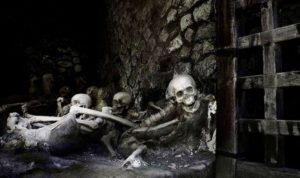
No one knows her name.
The hollow cavities that once held her eyes in her last, terrifying, desperate moment of life nearly 2,000 years ago stared back at me in silence. Surrounded by the articulated skeletal remains of family and friends, her bones told a story of a catastrophe that still echoes across time to this day. I was peering into a cave-like construction that once housed fishing equipment — one among 12 of them — neatly arranged as built in a straight-line row along the back perimeter of what is today a flat but stoney surface. It defined the dimensions of what was once an ancient city’s inviting seaside beach……………
Cataclysm
Autumn, 79 AD.
That was when Mount Vesuvius, only 8 miles to the northeast and an imposing daily presence as viewed unobstructed by any person from the city’s streets, spewed an explosive assault on the upscale Roman community of Herculaneum. A series of preceding earth tremors and volcanic rumblings must have given many in the city fair warning and time to escape. However, beginning around 1:00 pm, the volcano emitted clouds of volcanic material thousands of meters into the sky, eventually forming a column that flattened near the top between 17 and 21 miles high, forming what Pliny the Younger described in his letter to Tacitus as the overall shape of a familiar Italian Umbrella Pine tree. Atmospheric winds at first blew the cloud material to the southeast, falling mostly in the direction of Pompeii and surrounding communities. Roofs collapsed in Pompeii under falling debris, but Herculaneum’s initial experience was different.
“The cloud was being blown toward the south,” explains John Shepherd, a British archaeologist who has studied and shown groups through Pompeii and throughout the Campanian region for years. “Herculaneum was just on the edge of that cloud, so just a small amount of lapilli accumulated here over approximately 18 hours, giving most people in Herculaneum sufficient time to escape, but also giving people a false sense of security — the reason why so many took shelter in the [boathouse] shelters [along Herculaneum’s ancient shoreline].”
______________________________
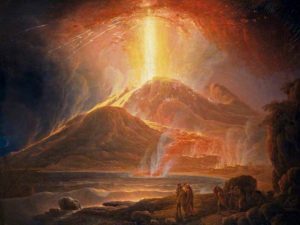
The Vesuvius Eruption. Painting by Jacob More (1740 – 1793), Public domain
______________________________

Map showing the cities and towns affected by the eruption of Mount Vesuvius in 79 AD. The general shape of the ash and cinder fall is shown by the dark area to the southeast of Mt Vesuvius. MapMaster, Attribution-ShareAlike 3.0 Unported (CC BY-SA 3.0), Wikimedia Commons
______________________________
But what appeared to be Herculaneum’s light and easy fate was not to last. By 1:00 am the next morning, the volcano’s massive eruptive column, like the twin towers in New York City on 9/11, began collapsing on itself, propelling a pyroclastic surge of ash and hot gases down the mountain and through the (now) mostly evacuated city at approximately 100 mph. The thunderous sound must have been terrifying for those remaining within earshot. One can only imagine the terror. Even in Misenum, across the Bay from Herculaneum and 5 miles farther from the erupting cataclysm, reactions were palpable. “We could hear women shrieking, children crying and men shouting,” writes Pliny the Younger. “Some were calling for their parents, their children, or their wives, and trying to recognize them by their voices [as darkness fell from the ash cloud]. Some people were so frightened of dying that they actually prayed for death. Many begged for the help of the gods, but even more imagined that there were no gods left and that the last eternal night had fallen on the world.”*
Many or most of the individuals and families who remained or lingered in Herculaneum, for whatever reasons, fled to the beach, where they had anticipated their escape by boats stored or docked near the boathouses, and by any additional efforts dispatched from nearby Misenum across the Bay. Possibly at least some of the remaining citizens on the beachfront were also simply the last in a long line or throng of people who early on had been escaping by boat dispatch over the past 18- 20 hours since the eruption began. Clinging desperately to hope, they had no idea they were facing their last moments of life. At least 350 people were left to their demise on the beach in that horrific event.
In the end, a total of six flows and surges eventually buried the city to a depth of approximately 20 meters, or over 65 feet. By the time most of those flows occurred, everyone who remained in or near the city had already perished. As witnessed today by the results of years of painstaking archaeological excavation, there appeared to be little relative destruction in many areas, preserving structures, objects and victims to a remarkable degree. However, other areas suffered significant damage, felling or erasing walls, and destroying columns and other objects.
Huddled Terror
For almost 2,000 years Herculaneum was lost, hidden under 65 feet of hardened volcanic fallout. It was not until the early 18th century when evidence, in the form of statuary dug from work related to wells, began to emerge as a result of excavation. Excavations continued sporadically until the first and most significant, systematic, large-scale excavations were conducted under Italian archaeologist Amedeo Maiuri from 1927 until 1942. That project uncovered approximately four hectares of the ancient city, the results of which show most of what visitors can see today.
_________________________________
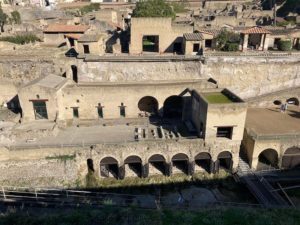
Above and below: Views of Herculaneum
_________________________________
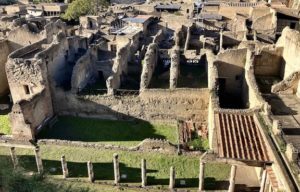
_________________________________
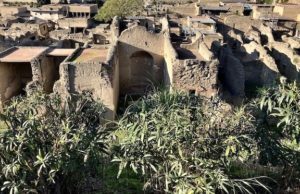
_________________________________
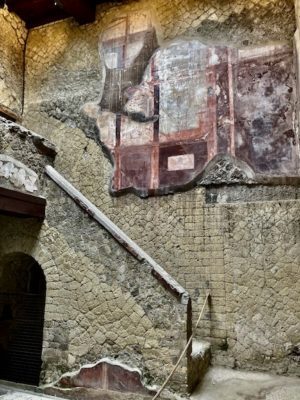
Above and below: Herculaneum’s structures, interior and exterior, were exceptionally well preserved as compared to other towns within the volcano’s eruptive shadow. Note the remarkable height preservation of the buildings.
_________________________________

_________________________________
The excavations also revealed a scarcity of victims. That is, until 1980, when archaeologists began to uncover skeletal remains in excavations along what was once the ancient shoreline, particularly within the remains of chambered structures the Romans had constructed to house fishing equipment along the shore. Work conducted in the early 1980’s and then in the 1990’s eventually uncovered hundreds of mostly articulated skeletons. It would show, after pain-staking excavation, a macabre and horrifying scene. Mostly women and children had been found huddled closely together within the boathouse chambers, capturing what appeared to be moments of desperate refuge within dark, confined spaces. But skeletal remains of men were also found laid out on the ancient beach area itself, including the much-publicized remains of a man interpreted by some scholars to have been a high-ranking Roman soldier who was part of Pliny the Elder’s naval rescue mission dispatched to save fleeing citizens of the city. Hs body was found face down, with remnants of armor, a saddlebag, a backpack containing carpenter’s tools, and a leather belt embellished with silver and gold foil, attached to which was also a decorated sword with an ivory handle. Near the body archaeologists found a dagger, a stack of 12 silver and two gold coins, and the remains of a boat (now housed in the Herculaneum museum). Forensic analysis indicated he was a man between 40 and 45 years old, healthy and had led a physically active life.
His efforts clearly proved futile. If he was attempting to help the hapless refugees huddled within the boathouses, it was too late. The first and deadliest pyroclastic surge made sure of that.
________________________________

Above: The ‘boathouses’ along the ancient Herculaneum seashore.
________________________________
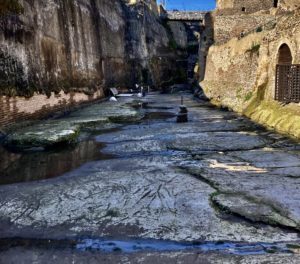
The ancient Herculaneum beachfront, where current excavations are taking place.
________________________________

The last boat in Herculaneum? Shown above is the well-preserved boat discovered on the ancient shoreline of Herculaneum.
________________________________
In the Blink of an Eye
Walking first through a tunnel, one of the first things I encountered when I approached ancient Herculaneum were the well-preserved remains of the12 boathouse structures, all aligned in a row, flanking both the left and the right as I entered and passed over a low-lying bridge, like crossing a castle drawbridge into the city. Looking closer at these boathouse structures, however, I could clearly see articulated skeletal remains within, scores of them, bunched together within the chambers, places that were normally used to store nets and fishing gear. This is where I met her staring back at me, like a ghost from the past. Now only a caste replica of the bones she left behind, I knew there was a lost, untold history and personality here that will never be known to today’s living generations.
At least for now, we know how she died, and how quickly………
Through research conducted by a number of researchers, including a team under the leadership of Pierpaolo Petrone* of the University Federico II in Naples, scientists have analyzed the skeletal remains of the victims. This research was built upon and confirmed results of previous bioarchaeological and taphonomic studies. Based on the previous studies and their knowledge of how extreme heat can effect the human body, they formulated a horrific and vividly graphic hypothesis for study: The first pyroclastic surge of superheated ash and gases moved rapidly over the victims at a temperature of approximately 500 degrees Celsius, equivalent to 932 degrees Fahrenheit. This was hot enough to instantly boil and vaporize blood and all soft tissue, causing many skulls to explode and teeth to break, and muscular contraction of hands, feet and essentially whole bodies. Death was instantaneous, occurring before anyone could even react defensively to the impact of the surge. The effect was the same for both victims located outside and inside the boathouse chambers. Ash quickly filled the cavities left by vaporized tissue, explaining why archaeologists uncovered skulls that were filled with hardened ash. The enveloping ash bed laid down by the surge cooled and hardened, encasing the victims in the positions and postures they assumed only a second before instantaneous death. What archaeologists encountered during excavation was the victims’ final second of life before death, frozen in time for nearly 2,000 years before discovery.
Recent studies have now confirmed the temperature of the deadly surge by conducting macroscopic analysis, optical microscopy, histochemistry and electron microscopy on bone samples of the victims from the sites most affected by the Vesuvius eruption. By comparing the data drawn from the ancient bone samples to that of modern bone samples subjected to high heat testing in the laboratory, they concluded that the ancient victims indeed experienced a rapid temperature elevation to about 500 degrees Celsius (932 degrees Fahrenheit at Herculaneum, 600 degrees Celsius (1,112 degrees Fahrenheit) in nearby Oplontis, and 250 – 300 degrees Celsius (482 – 572 degrees Fahrenheit) in Pompeii, each 6, 7, and 10 kilometers (3.7, 4.4, and 6.2 miles) from Vesuvius respectively. They further concluded that victims located within 10 to 20 kilometers from Vesuvius were also killed instantly from surge effects.
The most recent, 2018 study by Petrone* and colleagues provided additional evidence confirming the effects of the surge on the Herculaneum’s beach refugees and others found present on the beach front during flight and rescue efforts. Applying taphonomic and other laboratory investigation procedures on skeletal samples, his team found clear cut skull cracking similar to that observed with cremated remains, as well as skulls filled with ash which produced hardened ash castes of the cranial interior contours, suggesting that the surge was hot and fluid enough to fill intracranial cavities very soon after soft tissues had disappeared. Moreover, they observed a presence of a red mineral residue encrusting the bones and penetrating the cranial ash fills as well as the ash bed surrounding the skeletal remains. Mass spectrometry analysis revealed the red mineral substance as high in iron, suggesting it originated from body fluids — another sign pointing to rapid vaporization of body fluids and soft tissues due to exposure to extreme heat conditions.
Thus, though the horrific fear, struggle and desperation of residents in the erupting volcano’s vicinity endured for hours, it can now be conclusively stated that actual death came in a fraction of a second, hardly enough time to know ‘what hit them’, so to speak. Death was ironically merciful. But the emotional suffering of family and friends who must have mourned their loved ones, their bodies missing, unaccounted for beneath the massive, hardened ash layers, would no doubt have persisted long after their demise. No burials, no epitaphs or evidence to mark the physical presence of their remains would bear record of their passing for nearly 2,000 years. But now their remains, as finally revealed through archaeological investigations, will likely serve as a lasting memorial, though their identities remain sadly nameless.
_________________________________
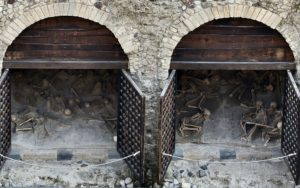
The skeletal remains of the victims within the ‘boathouse’ chambers can be clearly seen as one approaches Herculaneum from the ancient beachfront side. Public Domain, Wikimedia Commons
__________________________________________
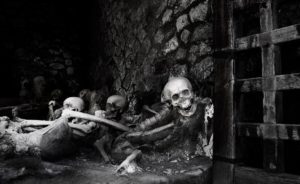
Bones found within one of the ‘boathouses’. SD. Chatane Creative Commons Attribution-Share Alike 4.0 International license, Wikimedia Commons
__________________________________________

Skeletal remains within one of the ‘boathouses’. Sally V., Creative Commons Attribution-Share Alike 4.0 International license, Wikimedia Commons
__________________________________________

Skeletal remains within one of the ‘boathouses’. Public Domain, Wikimedia Commons
__________________________________________
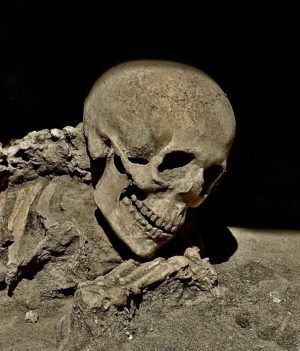
Closeup of a victim excavated within one of the ‘boathouse’ chambers. Ad Meskens, Creative Commons Attribution-Share Alike 4.0 International license, Wikimedia Commons
__________________________________________
Research and analysis on the remains continue. DNA testing and analysis will have more to say in the future. Just recently, for example, scientists have successfully sequenced the entire genome from an individual who died in Pompeii during the 79 AD eruption. Analysis showed that the individual was a male between 35 and 40 years old, may have suffered from tuberculosis, and had a DNA profile that was most similar to people living in central Italy today. And scholars and scientists alike await further future results from DNA studies of the victims at Herculaneum.
Petrone writes* about the future implication of the findings for today’s world —though the great eruptive events of Vesuvius are a matter of written and geologic history, the volcano and its surrounding geological environment are still very much alive. I sojourned the Vesuvius area only months before I penned this account for publication. As I traveled the region near the Bay of Naples, I could see hypothermal activity and fumaroles at a safe distance. I awoke to an earth tremor one morning. I had to remind myself that Vesuvius is still an active threat to all who walk in its shadow. In 79 AD, there were tens of thousands of people living daily lives in its vicinity.
Today there are three million.
___________________________________________
*https://igppweb.ucsd.edu/~gabi/sio15/lectures/volcanoes/pliny.html
*Petrone, Pierpaolo, The Herculaneum victims of the 79 AD eruption: a review, Journal of Anthropological Sciences, Vol. 97 (2019), pp. 68 – 89.
**Bioarchaeological and palaeogenomic portrait of two Pompeians that died during the eruption of Vesuvius in 79 AD, Scientific Reports, 26-May-2022.
_________________________________
Advertisement


